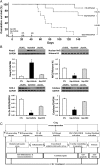Therapeutic efficacy of cardiosphere-derived cells in a transgenic mouse model of non-ischaemic dilated cardiomyopathy
- PMID: 24866210
- PMCID: PMC4368856
- DOI: 10.1093/eurheartj/ehu196
Therapeutic efficacy of cardiosphere-derived cells in a transgenic mouse model of non-ischaemic dilated cardiomyopathy
Abstract
Aim: Cardiosphere-derived cells (CDCs) produce regenerative effects in the post-infarct setting. However, it is unclear whether CDCs are beneficial in non-ischaemic dilated cardiomyopathy (DCM). We tested the effects of CDC transplantation in mice with cardiac-specific Gαq overexpression, which predictably develop progressive cardiac dilation and failure, with accelerated mortality.
Methods and results: Wild-type mouse CDCs (10(5) cells) or vehicle only were injected intramyocardially in 6-, 8-, and 11-week-old Gαq mice. Cardiac function deteriorated in vehicle-treated mice over 3 months of follow-up, accompanied by oxidative stress, inflammation and adverse ventricular remodelling. In contrast, CDCs preserved cardiac function and volumes, improved survival, and promoted cardiomyogenesis while blunting Gαq-induced oxidative stress and inflammation in the heart. The mechanism of benefit is indirect, as long-term engraftment of transplanted cells is vanishingly low.
Conclusions: Cardiosphere-derived cells reverse fundamental abnormalities in cell signalling, prevent adverse remodelling, and improve survival in a mouse model of DCM. The ability to impact favourably on disease progression in non-ischaemic heart failure heralds new potential therapeutic applications of CDCs.
Keywords: Cardiomyopathy; Cell transplantation; Heart failure.
Published on behalf of the European Society of Cardiology. All rights reserved. © The Author 2014. For permissions please email: journals.permissions@oup.com.
Figures








References
-
- Malliaras K, Li TS, Luthringer D, Terrovitis J, Cheng K, Chakravarty T, Galang G, Zhang Y, Schoenhoff F, Van Eyk J, Marbán L, Marbán E. Safety and efficacy of allogeneic cell therapy in infarcted rats transplanted with mismatched cardiosphere-derived cells. Circulation. 2012;125:100–112. - PMC - PubMed
-
- Li TS, Cheng K, Malliaras K, Smith RR, Zhang Y, Sun B, Matsushita N, Blusztajn A, Terrovitis J, Kusuoka H, Marbán L, Marbán E. Direct comparison of different stem cell types and subpopulations reveals superior paracrine potency and myocardial repair efficacy with cardiosphere-derived cells. J Am Coll Cardiol. 2012;59:942–953. - PMC - PubMed
-
- Lee ST, White AJ, Matsushita S, Malliaras K, Steenbergen C, Zhang Y, Li TS, Terrovitis J, Yee K, Simsir S, Makkar R, Marbán E. Intramyocardial injection of autologous cardiospheres or cardiosphere-derived cells preserves function and minimizes adverse ventricular remodeling in pigs with heart failure post-myocardial infarction. J Am Coll Cardiol. 2011;57:455–465. - PubMed
-
- Cheng K, Malliaras K, Li TS, Sun B, Houde C, Galang G, Smith J, Matsushita N, Marbán E. Magnetic enhancement of cell retention, engraftment, and functional benefit after intracoronary delivery of cardiac-derived stem cells in a rat model of ischemia/reperfusion. Cell Transplant. 2012;21:1121–1135. - PMC - PubMed
Publication types
MeSH terms
Substances
LinkOut - more resources
Full Text Sources
Other Literature Sources
Medical

